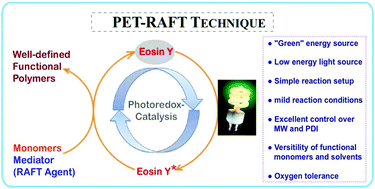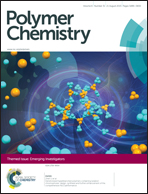Organo-photocatalysts for photoinduced electron transfer-reversible addition–fragmentation chain transfer (PET-RAFT) polymerization†
Abstract
In this article, we are investigating a series of organo-dyes, including methylene blue, fluorescein, rhodamine 6G, Nile red and eosin Y, to perform a visible light-mediated controlled/“living” radical polymerization of methacrylates. We demonstrate that eosin Y and fluorescein were efficient catalysts to activate a photoinduced electron transfer-reversible addition–fragmentation chain transfer (PET-RAFT) mechanism. The concentration of eosin Y was varied from 10 to 100 ppm with respect to monomers. This polymerization technique yielded well-defined (co)polymers with a good control of the molecular weights ranging from 10 000 to 100 000 g mol−1 and low polydispersities (PDI < 1.30). A variety of functional monomers, including N,N-dimethylaminoethyl methacrylate, hydroxyl ethyl methacrylate, pentafluorophenyl methacrylate, glycidyl methacrylate, oligoethylene glycol methyl ether methacrylate (OEGMA), and methacrylic acid, were successfully polymerized. Finally, the addition of a tertiary amine, such as triethylamine, afforded the polymerization in the presence of air via a reductive quenching cycle. Different diblock polymethacrylate copolymers, i.e. PMMA-b-POEGMA and PMMA-b-PMMA, were prepared to demonstrate the high end group fidelity.

- This article is part of the themed collections: Emerging Investigators and Celebrating The Five-Year Anniversary of Polymer Chemistry

 Please wait while we load your content...
Please wait while we load your content...